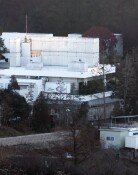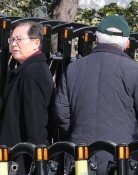Adapation to Weather Changes Needed
Adapation to Weather Changes Needed
Posted September. 24, 2010 17:45,
The Seoul metropolitan area saw heavy rain on the first day of the Chuseok (Full Moon Harvest) holidays Tuesday. The traditional gate Gwanghwamun in downtown Seoul was flooded, main roads were closed, and subway service was stopped at certain stations. A combined 14,000 households were flooded, including 8,000 in Seoul. The sudden downpour was beyond the scope of forecasting by the Korea Meteorological Administration. Though the weather agency forecast rain of 20 to 60 millimeters in the central region, the volume of rain was more than three times the expected amount in certain areas, including 259.5 millimeters in Seoul. The rainfall was the heaviest for the second half of September in 102 years.
The weather agency is under heavy criticism for its inaccurate forecast, but predicting recent weather patterns has grown harder. There are limits to science even with a super computer. Nonetheless, a more accurate forecast system is clearly needed to prepare for a sudden change in the weather.
Recent weather phenomena go beyond forecasts based on past experience. Between June to August this year, the average temperature was 1.3 degrees Celsius higher than normal. Last month also saw the most rainy days for August since 1973. Experts unanimously say such extreme weather is due to global warming-induced changes. The government also cannot spend a huge sum of money to prepare for natural disasters that strike once in 100 or 200 years.
Two western wards in Seoul, Yangcheon and Gangseo, suffered the most damage among affected regions. Generally, they are prone to flooding and cannot simply blame the weather agency. The Seoul city government and its district offices, which have paid little attention to disaster prevention measures, are also heavily responsible for this. Seoul suffered more damage from rain because rainwater was not drained off but flew backward. Given the standards of rainwater pump stations and drainpipes, the average rain frequency of a decade (77 millimeters per hour) is too lax to cope with new weather patterns. Stricter design standards should be applied to new facilities.
Average temperatures in Korea has risen 1.5 degrees over the past 100 years, twice the average increase of the earth`s (0.74 degree). The rise for Korea will be two degrees from 2000 to 2050. The Korea Environment Institute says economic damage will exceed an estimated 800 trillion won (689 billion U.S. dollars). The government should take preemptive action against weather changes and minimize trial and error first. Increasing water capacity through the four-river restoration project can be a major measure against climate change. Adaptation to weather changes is not required just for rivers but also for industries, cities and the ecosystem. People also must recognize that extraordinary weather patterns are becoming the norm and prepare themselves. This is how to survive a time of weather changes.







